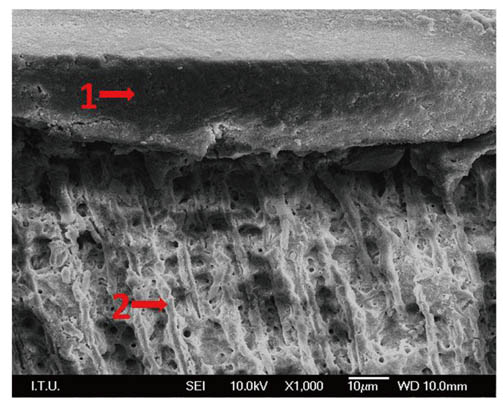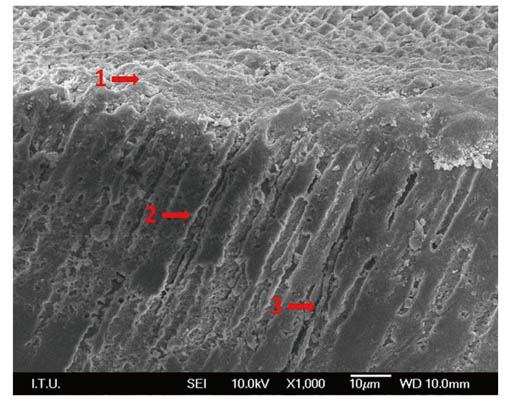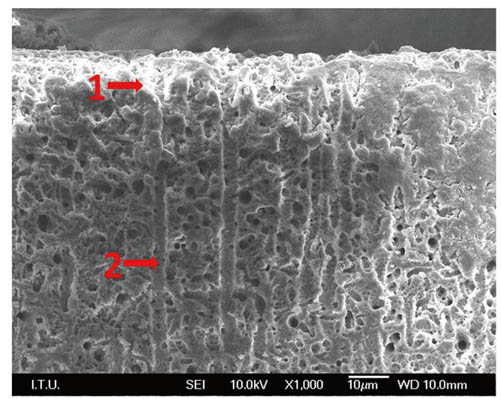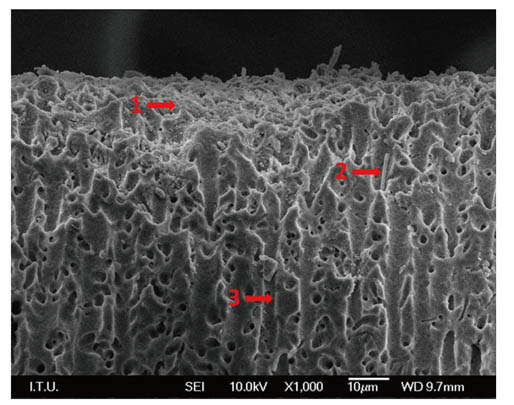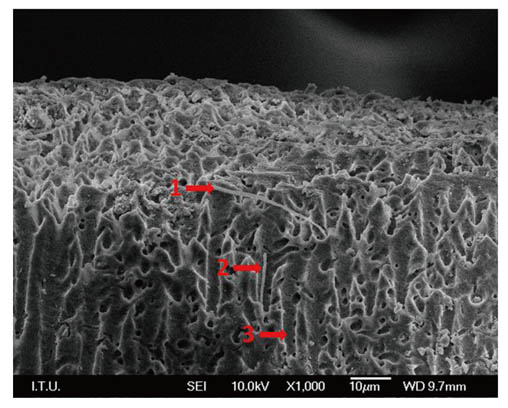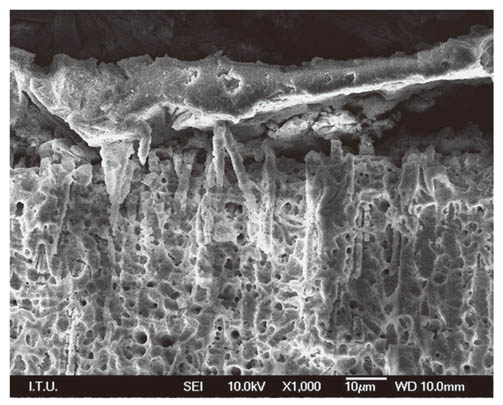J Adv Prosthodont.
2013 Aug;5(3):226-233. 10.4047/jap.2013.5.3.226.
Adhesion of 10-MDP containing resin cements to dentin with and without the etch-and-rinse technique
- Affiliations
-
- 1University of Istanbul, Faculty of Dentistry, Department of Prosthodontics, Istanbul, Turkey. vturp@istanbul.edu.tr
- 2University of Zurich, Dental Materials Unit, Center for Dental and Oral Medicine, Clinic for Fixed and Removable Prosthodontics and Dental Materials Science, Zurich, Switzerland.
- KMID: 2118160
- DOI: http://doi.org/10.4047/jap.2013.5.3.226
Abstract
- PURPOSE
This study evaluated the adhesion of 10-MDP containing self-etch and self-adhesive resin cements to dentin with and without the use of etch-and-rinse technique.
MATERIALS AND METHODS
Human third molars (N=180) were randomly divided into 6 groups (n=30 per group). Conventional (Panavia F2.0, Kuraray-PAN) and self-adhesive resin cements (Clearfil SA, Kuraray-CSA) were bonded to dentin surfaces either after application of 3-step etch-and-rinse (35% H3PO4 + ED Primer) or two-step self-etch adhesive resin (Clearfil SE Bond). Specimens were subjected to shear bond strength test using the universal testing machine (0.5 mm/min). The failure types were analyzed using a stereomicroscope and quality of hybrid layer was observed under a scanning electron microscope. The data (MPa) were analyzed using two-way ANOVA and Tukey's tests (alpha=.05).
RESULTS
Overall, PAN adhesive cement showed significantly higher mean bond strength (12.5 +/- 2.3 - 14.1 +/- 2.4 MPa) than CSA cement (9.3 +/- 1.4 - 13.9 +/- 1.9 MPa) (P<.001). Adhesive failures were more frequent in CSA cement groups when used in conjunction with two-step self-adhesive (68%) or no adhesive at all (66%). Hybrid layer quality was inferior in CSA compared to PAN cement in all conditions.
CONCLUSION
In clinical situations where bonding to dentin substrate is crucial, both conventional and self-adhesive resin cements based on 10-MDP can benefit from etch-and-rinse technique to achieve better quality of adhesion in the early clinical period.
Keyword
MeSH Terms
Figure
Cited by 1 articles
-
Do universal adhesives promote bonding to dentin? A systematic review and meta-analysis
Ali A. Elkaffas, Hamdi H. H. Hamama, Salah H. Mahmoud
Restor Dent Endod. 2018;43(3):. doi: 10.5395/rde.2018.43.e29.
Reference
-
1. Nakabayashi N, Kojima K, Masuhara E. The promotion of adhesion by the infiltration of monomers into tooth substrates. J Biomed Mater Res. 1982; 16:265–273.2. Tay FR, Gwinnett AJ, Pang KM, Wei SH. Variability in microleakage observed in a total-etch wet-bonding technique under different handling conditions. J Dent Res. 1995; 74:1168–1178.3. van Meerbeek B, Vargas M, Inoue S, Yoshida Y, Peumans M, Lambrechts P, Vanherle G. Adhesives and cements to promote preservation dentistry. Oper Dent. 2001; 6:119–144.4. van Meerbeek B, de Munck J, Yoshida Y, Inoue S, Vargas M, Vijay P, van Landuyt K, Lambrechts P, Vanherle G. Buonocore memorial lecture. Adhesion to enamel and dentin: current status and future challenges. Oper Dent. 2003; 28:215–235.5. Peumans M, Kanumilli P, de Munck J, van Landuyt K, Lambrechts P, van Meerbeek B. Clinical effectiveness of contemporary adhesives: a systematic review of current clinical trials. Dent Mater. 2005; 21:864–881.6. Yoshida Y, Nagakane K, Fukuda R, Nakayama Y, Okazaki M, Shintani H, Inoue S, Tagawa Y, Suzuki K, de Munck J, van Meerbeek B. Comparative study on adhesive performance of functional monomers. J Dent Res. 2004; 83:454–458.7. van Landuyt KL, Snauwaert J, de Munck J, Peumans M, Yoshida Y, Poitevin A, Coutinho E, Suzuki K, Lambrechts P, van Meerbeek B. Systematic review of the chemical composition of contemporary dental adhesives. Biomaterials. 2007; 28:3757–3785.8. van Landuyt KL, Yoshida Y, Hirata I, Snauwaert J, de Munck J, Okazaki M, Suzuki K, Lambrechts P, van Meerbeek B. Influence of the chemical structure of functional monomers on their adhesive performance. J Dent Res. 2008; 87:757–761.9. Wang T, Nikaido T, Nakabayashi N. Photocure bonding agent containing phosphoric methacrylate. Dent Mater. 1991; 7:59–62.10. Chigira H, Yukitani W, Hasegawa T, Manabe A, Itoh K, Hayakawa T, Debari K, Wakumoto S, Hisamitsu H. Self-etching dentin primers containing phenyl-P. J Dent Res. 1994; 73:1088–1095.11. Watanabe I, Nakabayashi N, Pashley DH. Bonding to ground dentin by a phenyl-P self-etching primer. J Dent Res. 1994; 73:1212–1220.12. Carvalho RM, Pegoraro TA, Tay FR, Pegoraro LF, Silva NR, Pashley DH. Adhesive permeability affects coupling of resin cements that utilise self-etching primers to dentine. J Dent. 2004; 32:55–65.13. Monticelli F, Osorio R, Mazzitelli C, Ferrari M, Toledano M. Limited decalcification/diffusion of self-adhesive cements into dentin. J Dent Res. 2008; 87:974–979.14. Madina MM, Ozcan M, Badawi MF. Effect of surface conditioning and taper angle on the retention of IPS e.max Press crowns. J Prosthodont. 2010; 19:200–204.15. Melo RM, Ozcan M, Barbosa SH, Galhano G, Amaral R, Bottino MA, Valandro LF. Bond strength of two resin cements on dentin using different cementation strategies. J Esthet Restor Dent. 2010; 22:262–268.16. Fujita K, Ma S, Aida M, Maeda T, Ikemi T, Hirata M, Nishiyama N. Effect of reacted acidic monomer with calcium on bonding performance. J Dent Res. 2011; 90:607–612.17. Özcan M, Mese A. Adhesion of conventional and simplified resin-based luting cements to superficial and deep dentin. Clin Oral Investig. 2012; 16:1081–1088.18. van Meerbeek B, Perdigão J, Lambrechts P, Vanherle G. The clinical performance of adhesives. J Dent. 1998; 26:1–20.19. Toledano M, Osorio R, Perdigao J, Rosales JI, Thompson JY, Cabrerizo-Vilchez MA. Effect of acid etching and collagen removal on dentin wettability and roughness. J Biomed Mater Res. 1999; 47:198–203.20. Erhardt MC, Cavalcante LM, Pimenta LA. Influence of phosphoric acid pretreatment on self-etching bond strengths. J Esthet Restor Dent. 2004; 16:33–40.21. Moszner N, Salz U, Zimmermann J. Chemical aspects of self-etching enamel-dentin adhesives: a systematic review. Dent Mater. 2005; 21:895–910.22. Mazzitelli C, Monticelli F, Osorio R, Casucci A, Toledano M, Ferrari M. Effect of simulated pulpal pressure on self-adhesive cements bonding to dentin. Dent Mater. 2008; 24:1156–1163.23. de Munck J, Vargas M, van Landuyt K, Hikita K, Lambrechts P, van Meerbeek B. Bonding of an auto-adhesive luting material to enamel and dentin. Dent Mater. 2004; 20:963–971.24. Goracci C, Cury AH, Cantoro A, Papacchini F, Tay FR, Ferrari M. Microtensile bond strength and interfacial properties of self-etching and self-adhesive resin cements used to lute composite onlays under different seating forces. J Adhes Dent. 2006; 8:327–335.25. Pisani-Proença J, Erhardt MC, Amaral R, Valandro LF, Bottino MA, Del Castillo-Salmerón R. Influence of different surface conditioning protocols on microtensile bond strength of self-adhesive resin cements to dentin. J Prosthet Dent. 2011; 105:227–235.
- Full Text Links
- Actions
-
Cited
- CITED
-
- Close
- Share
- Similar articles
-
- Microleakage and characteristics of resin-tooth tissues interface of a selfetch and an etch-and-rinse adhesive systems
- Effect of dimethyl sulfoxide on bond durability of fiber posts cemented with etch-and-rinse adhesives
- Influence of 10-MDP concentration on the adhesion and physical properties of self-adhesive resin cements
- Effects of endodontic tri-antibiotic paste on bond strengths of dentin adhesives to coronal dentin
- The effect of continuous application of MDP-containing primer and luting resin cement on bond strength to tribochemical silica-coated Y-TZP


